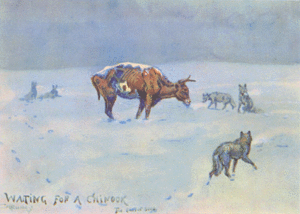Winter of 1886–1887 facts for kids
The winter of 1886–1887 was a super tough winter across North America, especially in the United States. People often call it the Big Die-Up because so many animals died. This winter hit the Western United States the hardest, especially the cattle industry. It completely changed how ranching worked and ended the time of the open range.
What Caused the Big Die-Up?
The summer before, in 1886, was very hot and dry. Many prairie fires broke out, and water sources dried up. This made it hard for cattle to find enough to eat and drink.
As fall arrived, people started seeing signs of a really bad winter coming. Birds flew south earlier than usual. Beavers collected more wood than normal for their winter homes. Even some cattle grew thicker, shaggier coats, as if preparing for extreme cold.
The Winter Arrives
The first snows fell in November, much earlier than expected. People said it was some of the worst snow they had ever seen. The cold was so extreme that it killed both people and animals. Some people even froze to death very close to their own homes after getting lost in the storms.
The harsh winter weather even reached the West Coast. On February 5, 1887, downtown San Francisco had 3.7 inches of snow. This was a record amount for the city.
How the Big Die-Up Affected Ranchers
Ranchers didn't fully realize how many animals they had lost until spring. When the snow melted, countless cattle bodies were found spread across the fields. Many were also washed down streams.
The few cattle that survived were in terrible shape. They were very thin and suffered from frostbite. Because of their poor health, these cattle sold for much less money. This caused many ranchers to lose everything and go bankrupt.
One famous person affected was Theodore Roosevelt, who later became a U.S. president. His cattle ranch near Medora, Dakota Territory was hit hard. He wrote to a friend, saying he was "utterly unable to enjoy a visit to my ranch" because of the huge losses. The Big Die-Up showed that the old way of "open range" ranching needed to change.


